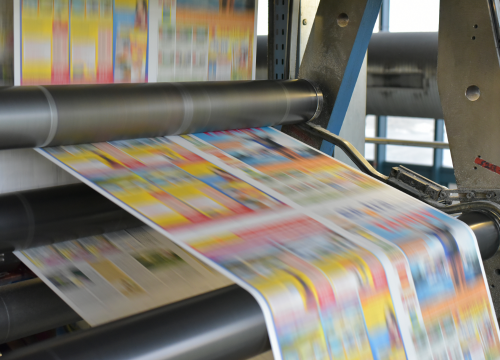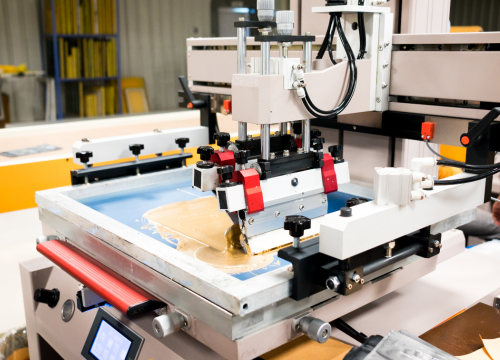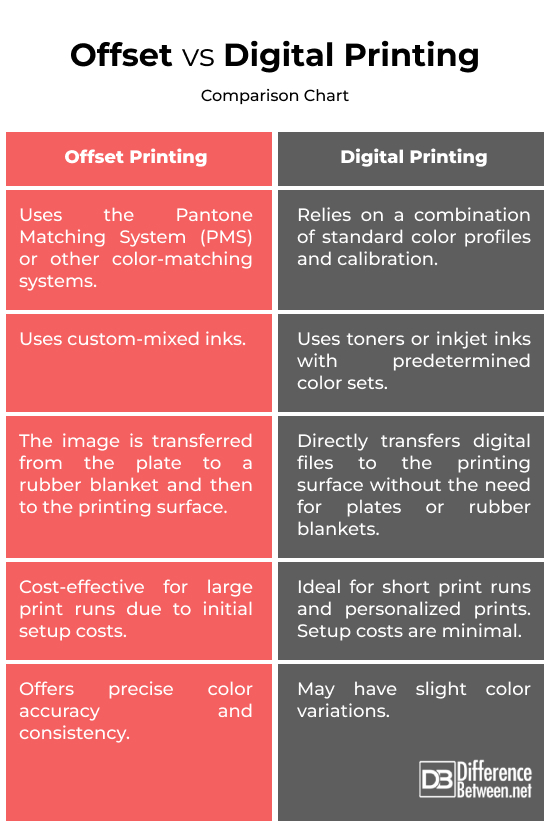Difference Between Offset and Digital Printing
In the realm of printing, there are two major and extensively utilized techniques: offset printing and digital printing. Both of these procedures utilize four-color printing technologies. Each method has its own set of advantages and provides a variety of approaches that can be utilized for a variety of production endeavors. Both approaches have their advantages, and the one that is selected is determined by the particular printing project needs.
Within the scope of this post, we will go into the specifics of these two processes and identify the primary distinctions that exist about them.

What is Offset Printing?
One of the most well-known printing technologies, offset printing, which is also commonly referred to as lithography, was first founded on the principle that oil and water repel one another. Although it is founded on the fundamentals of lithography, it has a contemporary flare to it. The image is transferred to an intermediary surface, which is a rubber blanket, before it reaches the final printing substrate, which is often paper. This is done rather than immediately transferring ink to the surface from which the printing is being done.
Because of the indirect character of the procedure, the term “offset” is used to describe it. Instead of being applied directly to the paper, the ink is offset onto the rubber blanket before the transfer process begins. In order to begin the process, metal plates are created for each color that will be used in the print job. Typically, there are four colors utilized: cyan, magenta, yellow, and black. Some regions of these plates are able to attract ink, while others are able to resist it.

What is Digital Printing?
Direct reproduction of digital files onto paper or other surfaces is the goal of the contemporary printing technique known as digital printing. In contrast to offset printing, which makes use of plates, it operates similarly to a large office printer. Due to the fact that it does not require a complicated setup, it is typically used for assignments that require a quick turnaround, short print runs, and personalized prints.
For lesser volumes, digital printing is more cost-effective than traditional printing since it eliminates the need for the fabrication of expensive plates. It is versatile since it enables you to simply change the content from one print to the next, which makes it an excellent choice for printing scenarios that require dynamic or customized printing.
Difference between Offset and Digital Printing
The Method of Printing
Printing using offset requires the use of plates and rubber blankets. After being moved from the plate to a rubber blanket, the image is subsequently transferred to the surface it will be printed on. The idea behind it is that water and oil do not mix together. This is the foundation of the idea.
On the other hand, digital printing is a technique that involves directly printing digital images onto a variety of substrates that are made of different types of media. In addition to eliminating the need for plates or rubber blankets, it transmits digital files directly to the surface that is being printed on.
Accuracy of Output and Color
When it comes to vast regions of solid colors and gradients, offset printing is particularly useful since it provides accurate color accuracy and consistently applied color. Because of this, it is appropriate for high-quality printing, which allows for the accurate mixing of bespoke color inks for each printing job.
In situations when the highest possible level of color accuracy is not the primary priority, digital printing is an excellent choice for various applications. The most recent digital printers are capable of producing colors that are vivid and accurate; however, there may be some tiny variances.
Printing of Data with Variables
Because offset printing is primarily intended for static printing, it is less suited to variable data printing, which is a type of printing in which each individual piece may have content that is unique to itself. On top of that, personalization is restricted.
It is possible to create individualized content in a single print job using digital printing, which is an excellent method. It is ideal for use in the production of individualized marketing materials, despite the fact that there may be slight variations in the color accuracy. In addition, items can be customized in an infinite number of ways!
Characteristics of the Ink
Due to the fact that offset printing makes use of custom-mixed inks, it is possible to produce precise color tones by fine-tuning. A significant factor that contributes to color constancy is the regulated application of ink on the printing surface.
Digital printing makes use of toners or inkjet inks that have color sets that have been established. Even while current digital printers offer a wide color gamut, there is still the possibility of differences occurring due to restrictions in the color spectrum that is available.
Offset vs. Digital Printing: Comparison Chart

Summary
In a nutshell, offset printing uses standard color-matching systems and custom-mixed inks for excellent color accuracy and consistency. It’s perfect for large print runs with precise color needs. On the flip side, digital printing is great for short runs and personalized projects, even though there might be slight variations in color accuracy.
FAQs
Which is cheaper digital or offset printing?
Digital printing is generally more cost-effective for shorter print runs, while offset printing is more economical for larger quantities due to the initial setup costs.
What is the difference between offset paper and digital paper?
The choice of paper depends more on the specific requirements of the printing project, such as paper weight, finish, and type, rather than the printing method used.
Is offset printing a digital printing process?
No, offset printing is not a digital printing process. Offset printing involves transferring ink from plates to a rubber blanket before applying it to the printing surface.
Which is better, offset or screen printing?
It depends on the project. Offset is great for high-quality and large print runs, while screen printing suits specialized applications and various surfaces.
Is there a big quality difference between digital and offset printing?
While offset printing generally offers superior color accuracy and consistency, digital printing has improved, and the quality difference is often minimal. The choice depends on factors like print quantity, customization needs, and budget.
What are the disadvantages of offset printing?
Offset printing has longer setup times, making it less suitable for quick turnaround projects. Initial setup costs may be a drawback for smaller print runs.
Why is offset printing so popular?
Offset printing is suitable for high-quality, consistent prints in large quantities. It excels in color accuracy, suitable for branding and marketing materials.
What is one downside to choosing offset as a printing method?
One downside to offset printing is the longer setup time required. This makes it less suitable for quick-turnaround projects compared to digital printing.
What lasts longer, screen printing or digital printing?
Screen printing generally lasts longer, especially for outdoor or wear-and-tear applications. Its durable inks and materials resist fading and damage better than digital prints.
- Difference Between Caucus and Primary - June 18, 2024
- Difference Between PPO and POS - May 30, 2024
- Difference Between RFID and NFC - May 28, 2024
Search DifferenceBetween.net :
3 Comments
Leave a Response
References :
[0]Image credit: https://www.canva.com/photos/MADrrn7Thgw-screen-and-digital-printing-machine-in-action-inside-packaging-factory-printing-pouches/
[1]Image credit: https://www.canva.com/photos/MAEYdjiwUO8-roll-offset-print-machine-in-a-large-print-shop-for-production-of-newspapers-magazines/
[2]Wiley, Natalie. “The Difference Between Offset and Digital Printing.” Printivity, 23 May. 2023, www.printivity.com/insights/2014/05/27/whats-the-difference-between-offset-printing-versus-digital-printing/.
[3]“Offset vs. Digital Printing: Differences and Use Cases.” FSSI, 8 Sep. 2021, www.fssi-ca.com/offset-vs-digital-printing/.
[4]Handbook on Printing Technology (Offset, Flexo, Gravure, Screen, Digital, 3D Printing with Book Binding and CTP) 4th Revised Edition. Asia Pacific Business Press Inc., 2019.

Printing is a process of impressing letters, texts, pictures, images or figures on paper, cloth, plastic and other material. Particularly with ink on paper using a printing press. You can see this medium everywhere. It is used in news paper, brochures, business cards, invitations, magazines, books, etc. Here are the two most commonly used type of printing:
Offset Printing ink. For working on a wide range of printing surfaces including paper, cloth, wood, leather, metal, and plastic. If you use the Pantone® Matching System, offset printing will give you the best color match. Modern offset printing inks presses use computer-to-plate (CTP) systems, shortening the work flow and reducing cost via elimination of the film.
Dear sir
i want a printing machine who print in paper,cloth, plastics.
such as Banner,new years calender,plastic bag name print etc.
so that which machine i will beought pls infor me
thanks
Gokul SIngh
Mob-9412449583
There is no hard as fast rule as to the quantity where offset printing becomes more cost effective than digital printing. Depending on the job sepcifications, the number could be 500 or less, or even higher than 1,000. Typically, the simpler the printing job, the higher the threshold. For example, a simple black ink on bond, one sided might be cheaper to produce digitally in quantities up to 3 or even 4 thousand, depending on the market.